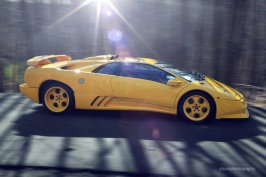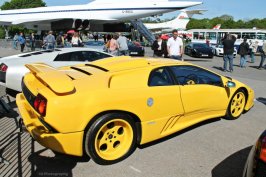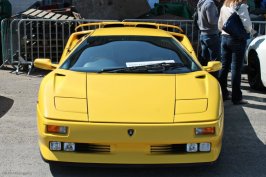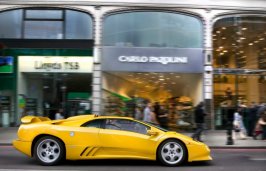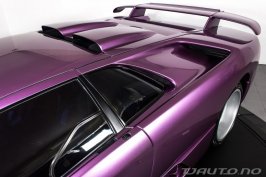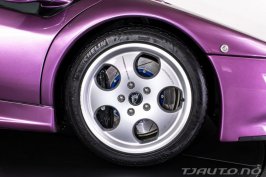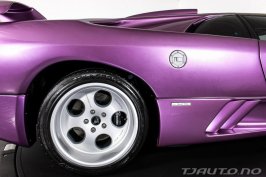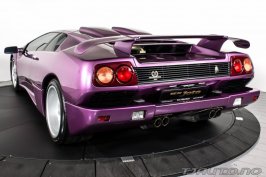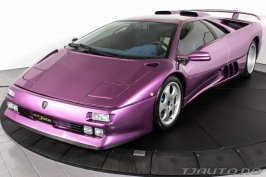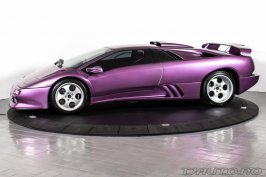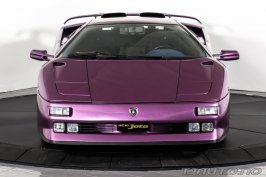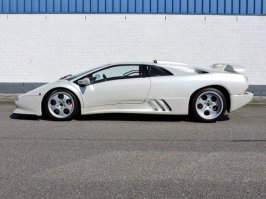- 215

- Michigan
- austin4500
The Diablo SE30 was introduced in 1994 as a limited-production special model to commemorate the company's 30th anniversary. The car was designed largely as a street-legal race vehicle that was lighter and more powerful than the standard Diablo. The engine received a healthy boost to 530 PS (390 kW; 523 hp) by means of a tuned fuel system, freer-flowing exhaust, and magnesium intake manifolds. The car remained rear-wheel drive to save weight, and omitted the electrically adjustable shock absorbers of the VT model, but it was equipped with adjustable-stiffness anti-roll bars which could be controlled from the interior, on the fly.
The car's weight was lowered by replacing the power glass side windows with fixed plexiglas (with a small sliding vent window as on many race cars) and removing luxury features such as the air conditioning, stereo, and power steering. Carbon fiber seats with 4-point race harnesses and a fire suppression system added to the race nature of the vehicle.
On the outside, the SE30 differed from other Diablo models with a revised front fascia featuring straked brake cooling ducts and a deeper spoiler, while the rear cooling ducts were changed to a vertical body-colored design. The raging bull emblem was moved from the front of the luggage lid to the nose panel of the car between the front indicators. The engine lid had slats covering the narrow rear window, while a larger spoiler was installed as standard equipment. The single rear fog lamp and rear backup lamp, which had been on either side of the rear grille, were moved into the bumper; this change would be applied to all Diablo models across the lineup. Completing the exterior variations were special magnesium alloy wheels, SE30 badging, and a new metallic purple paint color (this could be changed upon request).
Only 150 SE30 models were built, and of these, about 15 were converted to "Jota" specification (although 28 Jota kits were produced). The "Jota" was a factory modification kit designed to convert the race-oriented SE30 into an actual circuit racer, albeit at the cost of street-legal operation. A revised engine lid with two ducts protruding above the roofline forced air into the intake system; a similar lid design would later be used on the Diablo SV model. With even more tuning of the Diablo's venerable V12 engine, the Jota kit produced nearly 603 PS (444 kW; 595 hp) and 639 N·m (471 lb·ft) of torque. An open exhaust system produced deafening engine roar, one of the main contributing factors to the Jota's track-only status, although some owners converted back to standard exhaust in order to enjoy their "super Diablo" on the road. The rear-view mirror from the interior was also removed because it was completely useless in conjunction with the revised engine lid, further adding to the race feeling of the car.[8. ( from Wikipedia http://en.wikipedia.org/wiki/Lamborghini_Diablo#Diablo_SE30_and_SE30_Jota)



The car's weight was lowered by replacing the power glass side windows with fixed plexiglas (with a small sliding vent window as on many race cars) and removing luxury features such as the air conditioning, stereo, and power steering. Carbon fiber seats with 4-point race harnesses and a fire suppression system added to the race nature of the vehicle.
On the outside, the SE30 differed from other Diablo models with a revised front fascia featuring straked brake cooling ducts and a deeper spoiler, while the rear cooling ducts were changed to a vertical body-colored design. The raging bull emblem was moved from the front of the luggage lid to the nose panel of the car between the front indicators. The engine lid had slats covering the narrow rear window, while a larger spoiler was installed as standard equipment. The single rear fog lamp and rear backup lamp, which had been on either side of the rear grille, were moved into the bumper; this change would be applied to all Diablo models across the lineup. Completing the exterior variations were special magnesium alloy wheels, SE30 badging, and a new metallic purple paint color (this could be changed upon request).
Only 150 SE30 models were built, and of these, about 15 were converted to "Jota" specification (although 28 Jota kits were produced). The "Jota" was a factory modification kit designed to convert the race-oriented SE30 into an actual circuit racer, albeit at the cost of street-legal operation. A revised engine lid with two ducts protruding above the roofline forced air into the intake system; a similar lid design would later be used on the Diablo SV model. With even more tuning of the Diablo's venerable V12 engine, the Jota kit produced nearly 603 PS (444 kW; 595 hp) and 639 N·m (471 lb·ft) of torque. An open exhaust system produced deafening engine roar, one of the main contributing factors to the Jota's track-only status, although some owners converted back to standard exhaust in order to enjoy their "super Diablo" on the road. The rear-view mirror from the interior was also removed because it was completely useless in conjunction with the revised engine lid, further adding to the race feeling of the car.[8. ( from Wikipedia http://en.wikipedia.org/wiki/Lamborghini_Diablo#Diablo_SE30_and_SE30_Jota)
Last edited:


